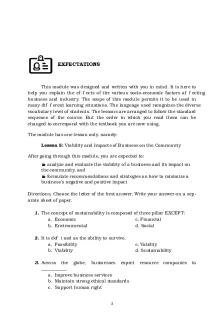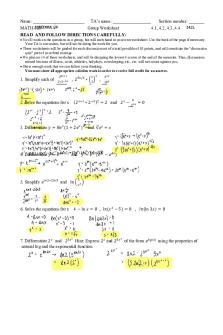1 Biodiversity and human impacts worksheets BIointeractive PDF

| Title | 1 Biodiversity and human impacts worksheets BIointeractive |
|---|---|
| Author | Michael Fam |
| Course | Thermische fysica |
| Institution | Universiteit Gent |
| Pages | 3 |
| File Size | 191.9 KB |
| File Type | |
| Total Downloads | 20 |
| Total Views | 135 |
Summary
Document for something about something i think maybe perhaps, possibly, not sure, is this a good word count, hopefully....
Description
BiomeViewer: Biodiversity and Human Impacts
Apps Student Worksheet
OVERVIEW This worksheet is designed to familiarize you with the many features found in BiomeViewer. TIPS FOR USING THE APP You can use BiomeViewer online or download an iPad version from the App Store. Click and hold the globe to spin it and explore different parts of the world. Click and release a spot on the globe to drop a pin there to see a summary of the characteristics of the biome for that location. You can also search for locations by name, latitude/longitude, or zip code. In the biome summary panel, click on “More” to see a longer description, photos, a larger climate graph, and wildlife data. Click on “Compare” to view details on two biomes side by side. On the biomes legend, use the arrows at the top to see different layers including anthromes, temperature, precipitation, and terrain. Click the gear icon to toggle gridlines and political boundaries on and off. Click on the globe icon to switch between a spherical view and a flat projection of Earth. BIODIVERSITY AND LATITUDE 1. Drop the pin on any point in one of the biomes listed in Table 1 below and record the following: Sonoran Deseert Biome name: ____________________________ 24.8°S, 10.3° E Latitude and longitude: __________________________ 11°C Range of temperatures: Minimum __________________ 14 Range of rainfall: Minimum __________________
31°C Maximum __________________
45 Maximum __________________
128 Total number of species (richness): _________________
2. Share the data you collected with your classmates and complete Table 1 as others share their data. Pick just one representative location for each biome. Table 1. Characteristics of some representative biomes.
Biome
Latitude
Species Richness
24.8°S
128
Tundra Boreal Forest Temperate Deciduous Forest Desert Tropical Rain Forest Alpine
Ecosystems www.BioInteractive.org
Published January 2018 Page 1 of 3
Apps Student Worksheet
BiomeViewer: Biodiversity and Human Impacts
3. Based on the completed table, do an “I see, I think, I wonder” activity by completing Table 2. Table 2. Questions about patterns in biomes.
I see What patterns do you observe?
I see that the arid Deserts of the world all have a similar temperature and rainfall.
I think What can you infer from the patterns?
I can infer that all desert need to have a similar level of rainfall and temperature in order to stay as deserts.
I wonder What else would you like to explore?
Different biomes to see the differences in patterns.
4. Change the view to a flat map and turn on the gridlines. Click on the Sahara Desert near the Tropic of Cancer. Click “compare” and select the tropical rain forest biome in Southeast Asia at about the same latitude. Then, answer the following questions: a. How do rainfall and temperature patterns differ between the biomes?
There is subtantially more rainfall in the tropical rainforest biome with signifactly lower temperatures in comparison to the Saharan Desert
b. List the species richness for each biome. Including fauna: 800 Sahara Desert: ______________
2216 SE Asia Tropical Forest: _____________
c. Think about the difference or similarity in species richness between these two biomes. What could account for this difference or similarity?
The added rainfall and lowered temperatures in the rainfirest account for this difference, allowing more species to survive.
Ecosystems www.BioInteractive.org
Published January 2018 Page 2 of 3
BiomeViewer: Biodiversity and Human Impacts
Apps Student Worksheet
HUMAN IMPACTS ON BIODIVERSITY 5. Go back to your original biome from question 1. Make sure you are still in flat map view. Change to the Anthrome layer and select the year 2000. a. Select the point in your biome with the highest level of human disturbance. List the Anthromes at this location for each of these years:
Wildlands + Seminatural 1700: _________________________ Wildlands + Seminatural 1800: _________________________ Wildlands + Rangelands + Croplands 1900: _________________________
2000: _________________________ Wildlands + Rangelands + Croplands + seminatural + villages
b. Briefly summarize how humans have impacted the environment at this location over time.
Humans have impacted this location over time by changing most of the wildlands to croplands and range lands. for question c): Banner-tail kangaroo rat, black-foted ferret, Mexican long-tongued bat c. At this location, record the following: Anthrome (year 2000): _______________________ Wildlands + Rangelands + Croplands + seminatural + villages
128 Species Richness: ________________ # Species NOT listed as “Least Concern”: ___________ d. Now select the point in your biome with the lowest level of human disturbance. Ideally, it should be a wilderness area, but as close as possible to the last location. Record the following:
Wildlands Anthrome: _______________________ 105 Species Richness: ________________ None # Species NOT listed as “Least Concern”: ___________ e. Summarize the differences in species richness and IUCN status of species between the two locations. Make a claim for how human disturbance could have impacted biodiversity in your biome. Support your claim with evidence.
Human disturbance msy hsve impacted the biodiversity by endangering some of the species. While the second location was much smaller, it still had a high level of species richness, due to little human disturbance.
Ecosystems www.BioInteractive.org
Published January 2018 Page 3 of 3...
Similar Free PDFs

Unit 1 - Biodiversity - Notes
- 20 Pages

Meiosis worksheets (1)
- 8 Pages

Viability and Impacts of Business
- 12 Pages

Worksheets
- 6 Pages

Criminology Worksheets 1-15
- 73 Pages

Biology Chapter 1 Worksheets
- 15 Pages

Unit 1 Worksheets - stuff
- 5 Pages

Latin Verb and Noun Worksheets
- 4 Pages
Popular Institutions
- Tinajero National High School - Annex
- Politeknik Caltex Riau
- Yokohama City University
- SGT University
- University of Al-Qadisiyah
- Divine Word College of Vigan
- Techniek College Rotterdam
- Universidade de Santiago
- Universiti Teknologi MARA Cawangan Johor Kampus Pasir Gudang
- Poltekkes Kemenkes Yogyakarta
- Baguio City National High School
- Colegio san marcos
- preparatoria uno
- Centro de Bachillerato Tecnológico Industrial y de Servicios No. 107
- Dalian Maritime University
- Quang Trung Secondary School
- Colegio Tecnológico en Informática
- Corporación Regional de Educación Superior
- Grupo CEDVA
- Dar Al Uloom University
- Centro de Estudios Preuniversitarios de la Universidad Nacional de Ingeniería
- 上智大学
- Aakash International School, Nuna Majara
- San Felipe Neri Catholic School
- Kang Chiao International School - New Taipei City
- Misamis Occidental National High School
- Institución Educativa Escuela Normal Juan Ladrilleros
- Kolehiyo ng Pantukan
- Batanes State College
- Instituto Continental
- Sekolah Menengah Kejuruan Kesehatan Kaltara (Tarakan)
- Colegio de La Inmaculada Concepcion - Cebu







